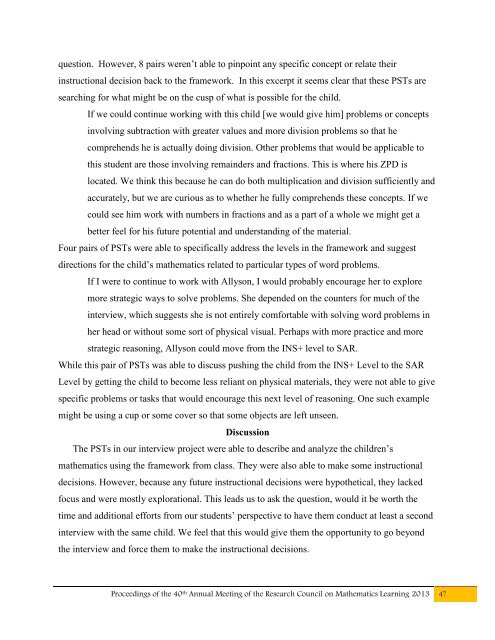2013 Conference Proceedings - University of Nevada, Las Vegas
2013 Conference Proceedings - University of Nevada, Las Vegas
2013 Conference Proceedings - University of Nevada, Las Vegas
- No tags were found...
Create successful ePaper yourself
Turn your PDF publications into a flip-book with our unique Google optimized e-Paper software.
question. However, 8 pairs weren’t able to pinpoint any specific concept or relate theirinstructional decision back to the framework. In this excerpt it seems clear that these PSTs aresearching for what might be on the cusp <strong>of</strong> what is possible for the child.If we could continue working with this child [we would give him] problems or conceptsinvolving subtraction with greater values and more division problems so that hecomprehends he is actually doing division. Other problems that would be applicable tothis student are those involving remainders and fractions. This is where his ZPD islocated. We think this because he can do both multiplication and division sufficiently andaccurately, but we are curious as to whether he fully comprehends these concepts. If wecould see him work with numbers in fractions and as a part <strong>of</strong> a whole we might get abetter feel for his future potential and understanding <strong>of</strong> the material.Four pairs <strong>of</strong> PSTs were able to specifically address the levels in the framework and suggestdirections for the child’s mathematics related to particular types <strong>of</strong> word problems.If I were to continue to work with Allyson, I would probably encourage her to exploremore strategic ways to solve problems. She depended on the counters for much <strong>of</strong> theinterview, which suggests she is not entirely comfortable with solving word problems inher head or without some sort <strong>of</strong> physical visual. Perhaps with more practice and morestrategic reasoning, Allyson could move from the INS+ level to SAR.While this pair <strong>of</strong> PSTs was able to discuss pushing the child from the INS+ Level to the SARLevel by getting the child to become less reliant on physical materials, they were not able to givespecific problems or tasks that would encourage this next level <strong>of</strong> reasoning. One such examplemight be using a cup or some cover so that some objects are left unseen.DiscussionThe PSTs in our interview project were able to describe and analyze the children’smathematics using the framework from class. They were also able to make some instructionaldecisions. However, because any future instructional decisions were hypothetical, they lackedfocus and were mostly explorational. This leads us to ask the question, would it be worth thetime and additional efforts from our students’ perspective to have them conduct at least a secondinterview with the same child. We feel that this would give them the opportunity to go beyondthe interview and force them to make the instructional decisions.<strong>Proceedings</strong> <strong>of</strong> the 40 th Annual Meeting <strong>of</strong> the Research Council on Mathematics Learning <strong>2013</strong> 47




